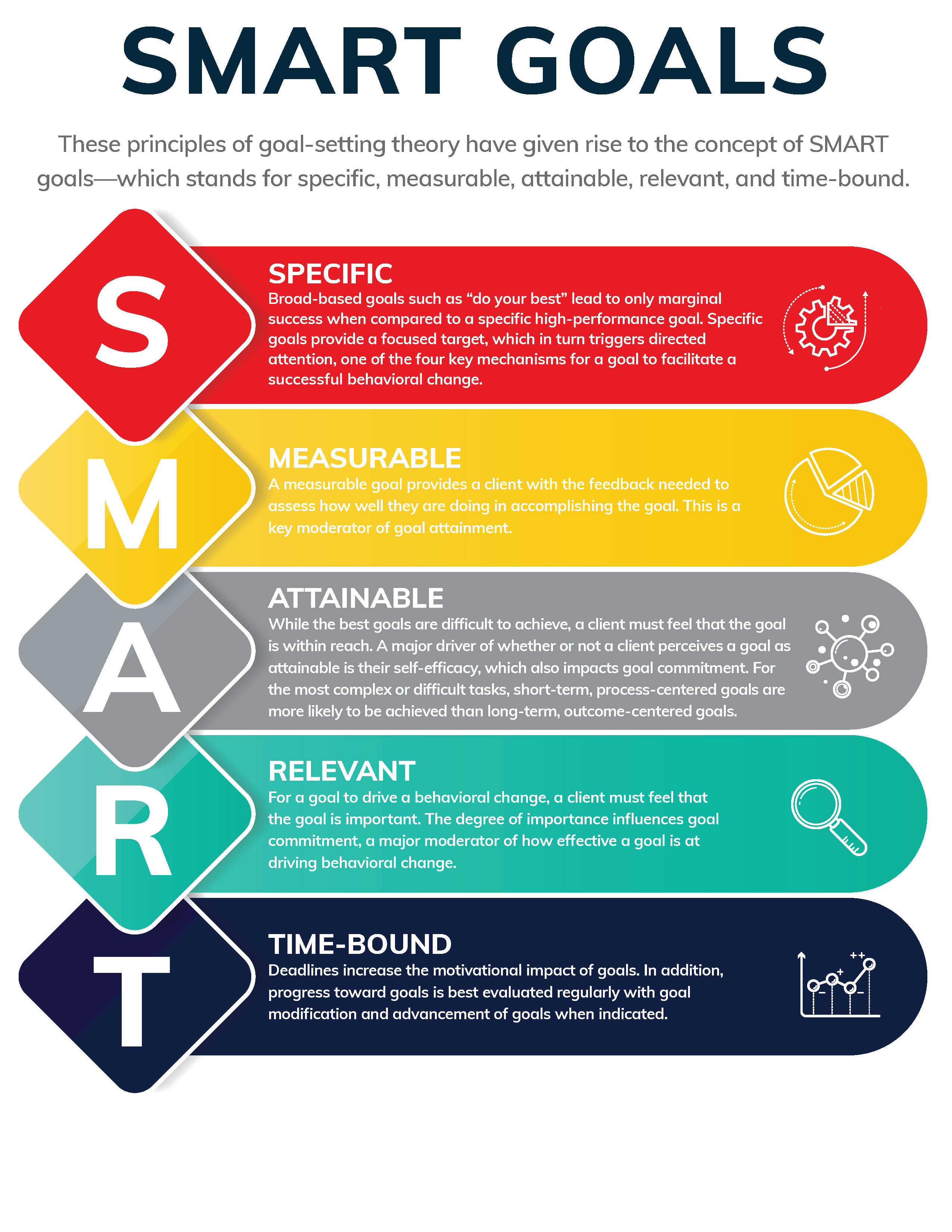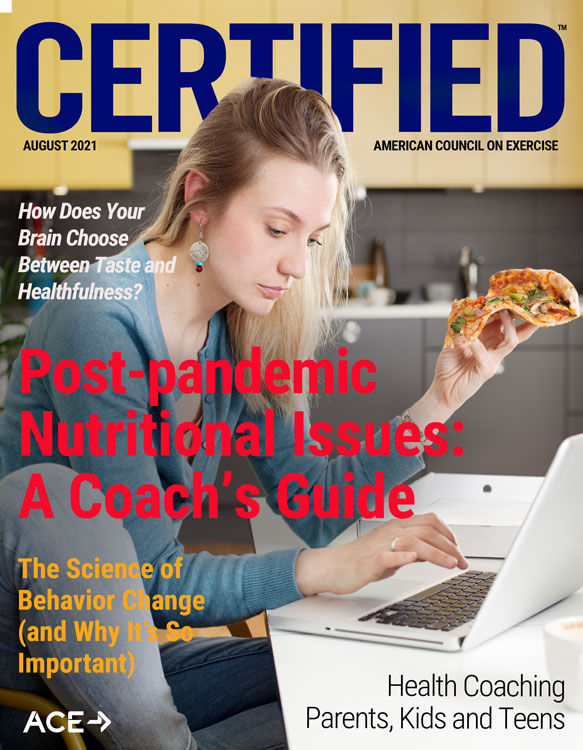
There is no question that the COVID-19 pandemic has taken a toll on most of us. As we emerge from more than a year marked by fear and uncertainty, the effects are becoming more evident. For many people, the stress, change of routines and social isolation brought about by the COVID-19 pandemic have created nutritional challenges that range from more frequent emotional and stress eating to increasingly disordered eating habits. Additionally, recent research suggests that the obesity epidemic has worsened for children over the past year, and similar outcomes are likely for adults as well.
The causes and triggers for these post-pandemic nutritional issues are relatively easy to identify, and include everything from working from home, gym closures, loss of childcare and unemployment to not seeing loved ones for an extended period, personal illness or caring for family members who are ill. Any of these could be contributing factors to the poor nutritional outcomes your clients may be experiencing. While some of these are not within their control, you can help your clients develop strategies that not only reduce the likelihood of making poor nutritional choices, but that can also positively impact their overall health and well-being. And people who exercise and develop healthy lifestyle habits may be better able to manage stress.
This article examines two of the more common issues that may be creating challenges related to healthy eating for your clients—frequent snacking or grazing and emotional eating—and describes how to coach your clients through these challenges. We also present a case study that demonstrates how to use the ACE Mover MethodTM and the ACE ABC ApproachTM to help a client who has gained weight since beginning to work from home at the start of the pandemic.
Post-pandemic Coaching Strategies
Client Issue: A lack of structure and more time at home with unlimited access to pantry/refrigerator (due to working from home, homeschooling kids, etc.) has led to increased snacking and lack of structured mealtimes.
Whether we realize it or not, daily routines and habits—whether they are positive or negative—shape our behaviors in a way that is often unconscious. Having to be at a specific location for work at a certain time for a set number of hours per day creates inherent constraints on our behaviors—constraints that were removed once many of us started working from home. And easy access to one’s kitchen and all it contains can make even the most disciplined person overindulge when stress or boredom strike.
If a client mentions that they have made a habit of increased snacking because they are spending more time at home, the following talking points may be helpful when collaborating to set goals:
- Planning meals and snacks ahead of time (and having them prepped when possible) can make decisions easier in the moment. If your client isn’t into planning meals on a daily or weekly basis, simply considering the day’s meals and snacks the night before can be helpful come mealtime and reduce decision-making in the moment or at a point when they are already hungry.
- Having a specific location to eat while at home (without the laptop in sight!) can make meal and snack times feel independent of the work routine and break the grazing habit. If your client works at the dining table or other typical eating spot in the house, making an extra effort to have all screens put aside (or even going outside for a lunch break) can allow them to be more mindful during mealtime. Having to “get up” and go to the eating location to have a snack—even if it’s across the room—can help to minimize constant snacking.
- For busy clients, taking the work out of cooking is key to sticking with nutrition-related goals. Convenience foods such as pre-chopped fruit or vegetables, salad kits, vegetable trays, rotisserie chicken, pre-boiled eggs, protein powders or drinks, whole-grain/chickpea/lentil pasta, and frozen/microwaveable brown rice can help clients overcome the hurdle of having to cook or meal prep to eat healthy while still providing nutrient-dense food options that are quick and easy. Making healthy foods as convenient as possible can eliminate the barrier of having to spend a lot of time in the kitchen.
- If snacking all day is a struggle, eating a nutrient-dense meal in the morning (especially one that is high in protein) can help your client feel satiated. Easy high-protein, high-fiber breakfasts include protein shakes with fruit/greens and protein powder, overnight oats with Greek yogurt and chia seeds and fruit, or pre-prepped egg “muffins” (eggs, cheese and vegetables combined and baked in a muffin tin).
- If restaurant delivery for quick meals has become a lifeline for your work-from-home clients during the pandemic, helping them set up Instacart or other grocery delivery services can be beneficial and reduce the barrier of finding time to shop for groceries. If they prefer restaurant delivery, review their favorite menus with them to come up with go-to healthy meals they can order when time is tight.
Client Issue: A wide range of triggers, from stress and anxiety to boredom, has increased the use of emotional eating as a coping mechanism.
Unlike a client who grazes on readily available food all day, a client who stress eats typically eats large quantities of food as a way to manage emotions. While emotional eating is often prompted by a desire to avoid the discomfort of stress or anxiousness, it can also be celebratory or used as a “reward.” Many of the coaching strategies described earlier for overcoming constant snacking can be helpful for curbing emotional eating as well, but placing a break or buffer between the emotion and the food can be particularly effective in preventing emotional eating episodes.
If a client has expressed interest in breaking the stress-eating habit, use the following talking points when collaborating to set goals:
- Discuss the stressors or emotions that cause your client to emotionally eat. If they are regularly stressed about the same thing every day or week (a regular meeting at work, a conflict with a family member, etc.) help them plan how they want to react to the situation the next time it happens. How do they want to feel? What do they really have control over and what can they let go of?
- Educate your client about the benefits of eating protein and fiber throughout the day to keep hunger levels in check. Intense hunger combined with cravings can lead to bingeing.
- When a client has a craving (that is emotional, not hunger-related), encourage them to set a timer for 15 to 20 minutes to allow them to feel and process the emotion and decide whether to eat the food. Feeling or processing the emotion can involve noticing and naming the feeling and then noticing what it feels like in the body (e.g., hot or cold, intense or dull). It can also be helpful to note that these feelings aren’t a problem to be “solved,” but rather a normal part of life. These feelings may be uncomfortable, but they don’t require “fixing” or numbing.
- Discuss “net-positive” activities that can help your client cope with stress. Emotional eating feels positive in the moment, but it is “net-negative,” as it hinders them from achieving their goals and may leave them feeling bloated or sick afterward. Net-positive stress-relieving activities might include activities such as journaling, walking, calling a friend, watering plants, deep breathing, doing some type of art such as watercolor or coloring books, meditation, a workout video, doing a puzzle or taking a hot bath or shower.
- Explore with your client the option of only eating “trigger” foods only outside the home. If your client loves ice cream, but regularly overeats it, plan a day to go out for ice cream rather than keeping a large quantity in the freezer. By planning to eat the food ahead of time, they know it’s not restricted and can anticipate going out, while not keeping it at home can set them up for success.
Case Study
The following case study features the ACE Mover Method, which is founded on the following tenets:
- Each professional interaction is client-centered, with a recognition that clients are the foremost experts on themselves.
- Powerful open-ended questions and active listening are utilized in every session with clients.
- Clients are genuinely viewed as resourceful and capable of change.
The key to applying the ACE Mover Method is the ACE ABC Approach:
- Ask open-ended questions
- Break down barriers
- Collaborate
A new client, age 41 years, comes to you for health coaching. They tell you that they began working from home in April 2020 and have since gained 20 pounds. The client's intake questionnaire indicates that they snack frequently, eat while working on their laptop and regularly order food delivery.
Ask Open-ended Questions
Using the ACE ABC Approach, you begin by asking open-ended questions, such as:
- Tell me more about your change in routines over the past year.
- What does a typical day of eating look like?
- You mentioned gaining 20 pounds in the past year. Thinking back over this time, what do you think is the number-one habit that contributed to this weight gain?
- What would you say is your number-one goal for a year from now? Three months from now? What habits, being as specific as possible, would be different in your daily life once you accomplish that goal?
Your client indicates they would like to lose at least the 20 pounds gained over the past year. The client notes a lack of structure around meals but feels stressed about figuring out new meal or snack ideas. They usually snack while working and frequently eat both breakfast and lunch with the phone and/or laptop in view to respond to emails. The client shares that they prefer salty snacks and often eat mixed nuts, chips or crackers with cheese. Over the coming months, they will continue to work from home at least a few days per week and would like some guidance in improving their nutrition while at home. The client also shares that they would like some ideas for easy breakfasts to take on the go when heading into the office.
Break Down Barriers
Your next step is to help your client identify and address any barriers that may prevent them from achieving the goals they discussed with you. This is the time to ask questions such as:
- What obstacles might get in the way of your goals?
- What is most challenging about eating healthful meals at home right now?
Your client tells you their biggest concerns are related to snacking and not using self-control in the home environment. They are open to the idea of not eating while sitting at their desk, and instead having all meals and snacks at the dining table to more effectively separate mealtime from working. They are also open to meal planning and grocery shopping rather than using food delivery, but aren't sure where to begin and don't have high confidence in being able to meal plan. The client also shares that they began using food-delivery services to order from nearby restaurants last year and have continued to do so a few times per week.
Collaborate
This final step of the ACE ABC Approach is all about collaboration as you and your client work together to set SMART (specific, measurable, attainable, relevant and time-bound) goals and establish specific steps to move closer to achieving those goals. Allowing the client to lead the discussion of how to monitor and measure progress empowers them to take ownership of their personal behavior-change journey. In this scenario, you might ask your client:
- What options do you have that will help you reach your goal?
- What can I do as your coach to support you in being able to plan meals or make healthier choices at home?
- In the long run, what do you think is the benefit of not snacking all day and taking time to eat meals?

Your client decides they would prefer not to be eating or snacking all day, which leads to a discussion about scheduling meals and snacks. In the past, having a defined schedule (e.g., commute, working in an office setting, gym time) helped to prevent grazing all day; while working from home, however, a more conscious effort will need to be made to adhere to a set schedule when working from home.. The client uses a calendar app and wants to try using calendar reminders as triggers for appropriate meal and snack times. Together, you work out a sample schedule:
Example:
7 am: Breakfast
10 am: Morning snack
12:30 pm: Lunch
3:00 pm: Snack
6:00 pm: Dinner
Your client decides that rather than keeping snacks at their desk, they will keep a water bottle to drink from throughout the day, and pre-portion mixed nuts ahead of time to avoid eating a large serving.
Finally, you help your client craft a SMART goal related to their nutrition and eating habits:
This week, I will use my meal and snack schedule while working from home on Monday, Wednesday and Friday. To make this easier, I will grocery shop on Sunday to ensure food is available and I will use my calendar reminders to help me stick to my schedule.
You and your client discuss easy, healthy snacks and meals that they enjoy and prepare a grocery list together that will help ensure their success.
Utilizing the ACE Mover Method in combination with SMART goal setting allows your clients to uncover, define and work toward an agreed-upon strategy for success that is tailored specifically to their unique needs and circumstances. It’s especially important to discuss any new barriers or stressors due to a change in routines over the past year. While some of these routines are no longer “new,” the lingering effects of stress can play into a client’s ability to sleep well, eat well or have enough energy for exercise. If stress is significantly altering a client’s ability to perform daily activities, be sure to recommend that they make an appointment to see their doctor.





 by
by 



